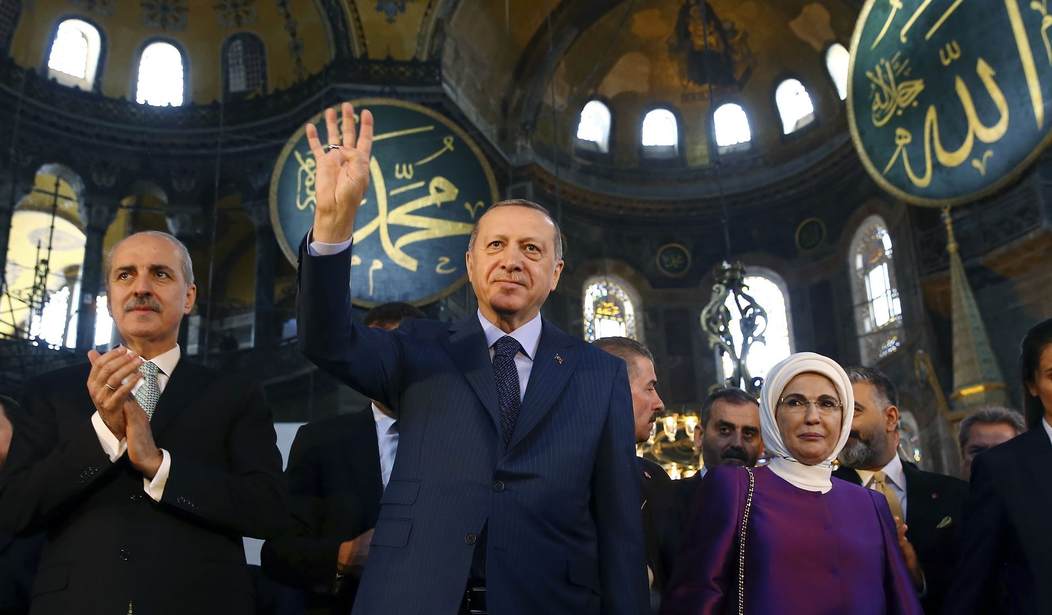Yesterday in Istanbul, Turkish President Recep Tayyip Erdogan attended a ceremony in honor of 136 young men who had succeeded in memorizing the entire Qur’an. The ceremony was held in what the International Quran News Agency called “the iconic Hagia Sophia Mosque,” which up until last year was a museum, although it was a mosque before it was established as a museum in 1935. “After 86 years of longing, we have experienced the happiness of returning Hagia Sophia to its original identity,” said Erdogan at that time. He was ignoring, however, Hagia Sophia’s near-millennium as a cathedral, and the catastrophic events that led to its becoming a mosque – events that took place on this day in 1453, a day some Greek Orthodox Christians referred to as “the last day of the world.”
As The History of Jihad recounts in detail, on Tuesday, May 29, 1453, the armies of the Ottoman Sultan Mehmet II finally broke through Constantinople’s defenses after a long siege, marking the end of the Eastern Roman Empire, more commonly known as the Byzantine Empire. The conquerors were extraordinarily brutal. Historian Steven Runciman notes that the Muslim soldiers “slew everyone that they met in the streets, men, women, and children without discrimination. The blood ran in rivers down the steep streets from the heights of Petra toward the Golden Horn. But soon the lust for slaughter was assuaged. The soldiers realized that captives and precious objects would bring them greater profit.”
Some jihadists “made for the small but splendid churches by the walls, Saint George by the Charisian Gate, Saint John in Petra, and the lovely church of the monastery of the Holy Saviour in Chora, to strip them of their stores of plate and their vestments and everything else that could be torn from them. In the Chora they left the mosaics and frescoes, but they destroyed the icon of the Mother of God, the Hodigitria, the holiest picture in all Byzantium, painted, so men said, by Saint Luke himself. It had been taken there from its own church beside the Palace at the beginning of the siege, that its beneficient presence might be at hand to inspire the defenders on the walls. It was taken from its setting and hacked into four pieces.”
The jihadists also entered the Hagia Sophia, which for nearly a thousand years had been the grandest church in Christendom. The faithful had gathered within its hallowed walls to pray during the city’s last agony. The Muslims halted the celebration of Orthros (morning prayer); the priests, according to legend, took the sacred vessels and disappeared into the cathedral’s eastern wall, through which they shall return to complete the divine service one day. Muslim men then killed the elderly and weak and led the rest off into slavery.
Once the Muslims had thoroughly subdued Constantinople, they set out to Islamize it. According to the Muslim chronicler Hoca Sa’deddin, tutor of the sixteenth-century Sultans Murad III and Mehmed III, “churches which were within the city were emptied of their vile idols and cleansed from the filthy and idolatrous impurities and by the defacement of their images and the erection of Islamic prayer niches and pulpits many monasteries and chapels became the envy of the gardens of Paradise.”
It has come to be known as Black Tuesday, the Last Day of the World. Tuesday has been regarded as unlucky by superstitious Greeks ever since. But they’re about the only ones who remember. The world has forgotten what happened on Black Tuesday, and on so many other days like it from India to Spain, and persists in the fantasy that Islam does not contain an imperialist impulse and that Muslims can be admitted without limit into Western countries without any attempt to determine how many would like ultimately to subjugate and Islamize their new countries, the way their forefathers did to Constantinople so long ago.
Oh, and there are a few others who remember as well. Sheik Ali Al-Faqir, former Jordanian minister of religious endowment, said this on Al-Aqsa TV on May 2, 2008: “We proclaim that we will conquer Rome, like Constantinople was conquered once…” Hamas MP and Islamic cleric Yunis Al-Astal said this, also on Al-Aqsa TV several years ago: “Very soon, Allah willing, Rome will be conquered, just like Constantinople was, as was prophesized by our Prophet Muhammad.”
Islam’s most popular TV preacher, Sheikh Yusuf al-Qaradawi, remembers also. In writing about “signs of the victory of Islam,” he referred to a hadith: “The Prophet Muhammad was asked: ‘What city will be conquered first, Constantinople or Romiyya?’ He answered: ‘The city of Hirqil [i.e. the Byzantine emperor Heraclius] will be conquered first’ – that is, Constantinople… Romiyya is the city called today ‘Rome,’ the capital of Italy. The city of Hirqil [that is, Constantinople] was conquered by the young 23-year-old Ottoman Muhammad bin Morad, known in history as Muhammad the Conqueror, in 1453. The other city, Romiyya, remains, and we hope and believe [that it too will be conquered].”
Mehmet the Conqueror was motivated by exactly the same religious ideology that motivates the Islamic warriors of the contemporary era. Historian Halil Inalcik says of the Ottomans that their “culture was dominated by the Islamic conception of Holy War or ghaza.” Ghaza refers to warfare to expand the land under the hegemony of Islam — and thus it is not identical to jihad, but is one of the chief means of jihad. Inalcik continues: “By God’s command the ghaza had to be fought against the infidels’ dominions, dar al-harb (the abode of war), ceaselessly and relentlessly until they submitted.”
Mehmet himself explained as he argued for the necessity of conquering Constantinople: “The ghaza is our basic duty, as it was in the case of our fathers.”
Erdogan believes the same thing. In March 2020, journalist Abdullah Bozkurt reported: “President #Erdogan framed Turkish military cross-border offensive [against the Kurds in Syria] as religious war, recited a poem that describes Turkish army as the last army of Islam that dies for Allah. He promised that God supports #Turkey & everybody will see how capable the army is.”
The reconversion of Hagia Sophia to a mosque was for Erdogan all part of the same religious war. Making Hagia Sophia into a mosque again was a symbol of Islam’s triumph over secularism, just as its conversion to a museum in 1935 was a symbol of secularism’s triumph over Islam, and its original conversion to a mosque in 1453 was a symbol of Islam’s triumph over Christianity.
His aspirations, and those of his Leftist allies, must be thwarted if free societies are going to survive. May 29, Black Tuesday, the Last Day of the World, the true Nakba: today should be a day for all those threatened by Islamic jihad and Sharia oppression to redouble our efforts to resist, so that more such catastrophes may never again destroy the lives of free people.










Join the conversation as a VIP Member